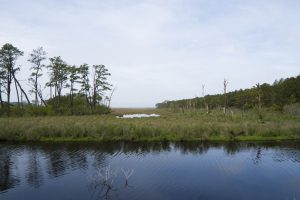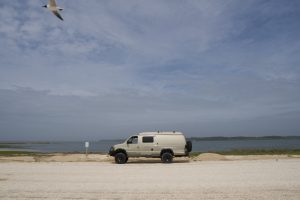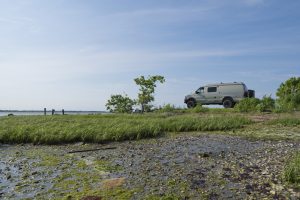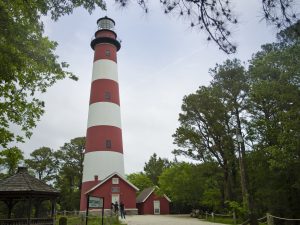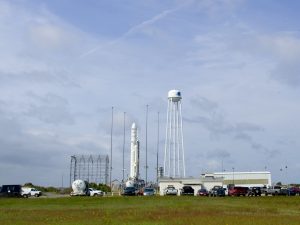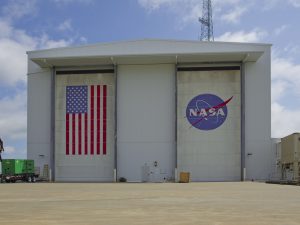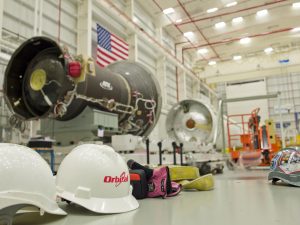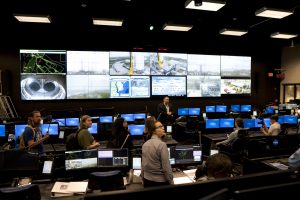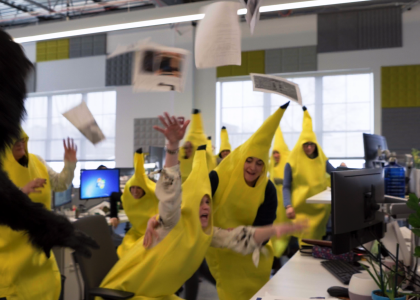It’s not every day that I connect with NASA. In fact, it’s never happened before. But on May 8, 2018 I received an email from NASA’s social media group notifying me that my application had been accepted to attend the next NASA Social event in Chincoteague, Virginia at the Wallops Flight Facility to watch the next Antares Orbital ATK rocket launch with the Cygnus spacecraft on a resupply mission headed to the ISS (International Space Station) – yes that was a mouth full.
I think it’s important to emphasize the coolness of the above. I’ve watched rocket launches online in the past but never have I seen one live. That’s not the cool part. The cool part is that when attending the NASA Social event, a group of people who are active in social media are given the behind the scene, up close and personal access to areas that only NASA, ATK, Wallops, Cygnus and other employees have access to. This is not some pay tour that just gets you past the visitor center, this is a specific tour NASA has put together that exposes social media users to a first-hand look at the cool things that are still going on at NASA, space, space travel, science and so much more!
To be clear, I had to pay my own way to the event and at no time did NASA ever direct me on what to say or show from the event. This was nothing more than “this is what we do, please share it if you want”. Share it, I will. I mean who wouldn’t want to see all the science that goes into a launch? Anti-scientist? Is there such a thing? Who wouldn’t want a “back-stage pass” to the coolest concert in town? I know I did and so I jumped on the opportunity to pack every camera I had, cancel the garage sale my family had planned and abandon my wife and daughter for the weekend to drive to Virginia to witness my first launch.
For me, there were so many unknowns, so many questions! How much gear do I bring? How close will I be to the launch? Do I get to see the rocket up close? Do I get to touch it? Why is the launch at 4:39 in the morning – you’re NASA, can’t you just launch these things at a more reasonable hour? Is the launch like NASCAR loud or just kinda loud? All of these questions and more will be answered on my trip. Read on for more.
Preparation for the Trip:
I brought almost every camera and lens I own. I didn’t know what I would need and I didn’t know exactly what they would let me bring onto the shuttle bus, behind the scenes or to the launch. I also brought two different camera bags not knowing what sort of day I was going to have. Was there going to be a lot of walking or sitting or standing around? Would I need a tripod? Would I even have time to set up a tripod for anything? I brought one of my studio LEDs to help light myself when vlogging at night (yes, I am serious). I brought clamps and stands and cables and chargers. I brought it all. Oh and I packed some clothes and food and stuff too.
The Trek Down:
The weather had been a concern all along for this launch and it was shaping up to be bad for the drive down as well. I had been watching the weather closely as I am sure everyone had been. Friday, the day I would set out on my 5-hour drive down to the Chincoteague area I received an update email from the NASA social team. The weather had ultimately been too much of a concern and the launch had been moved from Sunday at 4:39 am to Monday in the same time slot. After discussing with my family, I quickly adjusted my schedule, hit the local supermarket for additional food supply and embarked on what would be a very uneventful, but soggy drive down to Virginia. I won’t bore you with the details of my 5-hour drive but I will mention the flooded campground I discovered upon my 11 pm arrival that night. Apparently, this area had received a bunch of rain over the past few weeks so I more or less was camping in a swamp. The morning would reveal how extensive the flooding was, although I had had a pretty good idea because I had to use my flip flops to wade through the water that night to get to the bathroom so as not to soak my one and only pair of sneakers.
Saturday, Day 1:
Since the overall schedule had changed, the NASA Social group’s call time had moved from 8 am to 12 pm, which was nice. It gave me a chance to cook a full breakfast, make some coffee and get to know my surroundings… and by get to know my surroundings, I mean outside of the KOA campground. Since this blog post is supposed to be about the NASA Social event, I won’t share too much in the way of my explorations but I will say that I had never been to or even heard of Chincoteague prior to this adventure. I recommend it.
12 Noon was our call time for check-in where we would receive little goodie-bags and our official badges for the event. After a quick introduction led by Chelsey Ballarte (@chelseyballarte), who by the way was coordinating her very first NASA Social event and did a wonderful job, we jumped into the meat of the program: “Whats On Board Briefing” where a handful of scientists shared with us the science and experiments which were onboard the ATK Cygnus rocket set for launch in two days. Check out the video NASA posted on YouTube of the actual briefing: https://youtu.be/R6bisV6iK1Y I have to be honest here, I’m not a science person; I have an architectural background so much of what was shared with the group was all very new to me. However, one piece of science that was of particular interest to me was the idea of concrete in space. If we plan to colonize space someday, we’ll need to understand exactly how our customary construction materials will behave in microgravity. Check out the video above for more.
Day 1 ended as quickly as it began and I continued my own exploration of the Chincoteague Island area, even getting in a 5K run around the Wild Life Refuge loop in the state park, which cost $20/week for vehicle access, by the way.
Sunday, Day 2:
Sunday’s schedule was quite a bit more aggressive. In fact, it’s more or the less the original Saturday schedule but shifted one day and minus the check-in and “What’s on Board Briefing” parts.
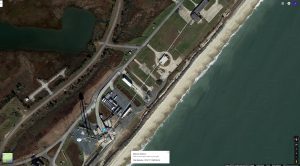
First destination, launch pad. Yes! The bus ride over was a bit of a hoot. As soon as we… and by we I mean the people on the right side of the bus saw the rocket in the distance, it was like we were a school bus of elementary school children slowly passing by a life-size T-Rex dinosaur on the side of the road. Shrieks and laughter of joy got everyone’s attention who were sitting on the left side of the bus. As we pulled up and exited the bus the reality of it all took over, for me anyway. Oh wait, that’s a half mile away! So… I was thinking we were literally headed to the launch pad, like up close and personal. Yes, that’s probably very naive of me. Maybe I need to ask more questions. Had I known we were going to be 1200ft away from the rocket, I would have brought a bigger/longer lens. All wasn’t lost, however, I did have my Hasselblad medium format camera in my backpack which has a 50MP CMOS sensor (photo nerd alert) so the photos I did take are large enough that I can zoom/crop in. The NASA social group took a bunch of selfies, giggled at the rocket’s awesomeness, I sorta giggled too, and as fast as their thumbs could type, posted photos on every social media platform known to… woman, man or child. Our time “at the pad” seemed so short and I immediately became the guy who would always be the last person on the bus because I was fussing with all of my gear. Yeah, that was me.
I have to say that the NASA Social schedule sorta set a high benchmark for the rest of the day in that the first thing we saw was the Antares Orbital ATK rocket on the pad poised and ready to go. How do you top that? The HIF is how. The HIF or Horizontal Integration Facility is the big hanger type building with massive sliding doors where they assemble rockets in the… horizontal position. Here they mate the main body with the engine, the Cygnus capsule, and other rocket parts before it is moved to the launch pad where it is then stood upright prior to launch. So yeah, being 1200ft from the Orbital ATK rocket on the launch pad that was about to blast off in less than 24hrs was pretty cool. Being 20ft away from a partially assembled rocket in an awe-inspiring hanger was just as cool, possibly cooler! Side note: how cool is having access to this space? So cool that we couldn’t bring any devices that transmitted signals like phones, smart watches, car key fobs, etc. Apparently, there was some very sensitive equipment in the space and the signals our day to day devices transmit could be a problem. What I am trying to convey is that NASA put a lot of trust in some social media junkies not to mess up their equipment. That’s how cool.
Ever wonder what it’s like to be at “mission control”? You know, like, with all of the monitors and rocket-science-people wearing headsets running down the checklist of “GO”, “NO-GO” before the launch? We were actually given permission to go into and walk around the floor of the RCC or Rang Control Center, aka “mission control” at NASA’s Wallops Flight Facility. I’m not talking about from the viewing area overlooking the main floor. I mean, I actually sat at one of the stations while Frank Bellinger (Technical Director) gave us a brief overview of how it all works. First few words out of his mouth, “don’t touch any buttons”. Believe it or not, they have an actual panel with a “destruct” button on it. Seriously. And if this wasn’t cool enough, Mr. Jim Bridenstine, you know, the 13th administrator of NASA, happened to be in the building and stopped by to say hello and take a group selfie! Of course, he was mobbed by the people who actually knew who he was… I sorta stood there and said quietly to myself “I should probably take a photo of this guy, he seems important”.
For some, the HIF may have been the be all end all but for this kid who grew up with a metal lathe and mill in his dad’s garage, the Sounding Rocket Tour was pretty sweet as well. The name of the tour really didn’t do it justice. In fact, it really didn’t seem to describe it at all. The Sounding Rocket facility is essentially a very large machine shop where they manufacture, build, assemble and test rockets. These rockets are different from the big ATK rockets on the launch pad we were there to cover. These rockets are smaller, 18″, 20″ and 24″ inches in diameter rockets, think large missiles, and carry smaller payloads into space. The machinery in this building was massive; some of the lathes were 30ft long, possibly bigger!
Last, but not least was a little off-topic tour of the Balloon Research Development Laboratory. Although not directly related to rockets, these massive balloons can carry 5000lbs or more of science cargo into the upper atmosphere to do all kinds of experiments – I guess as close to space without actually being in space. Most impressive of all was that these balloons were made of a plastic, not unlike a kitchen trash bag, and can be as big as Yankee stadium once fully inflated. Who knew? Probably smart people who are into this sort of thing but it was news to me!
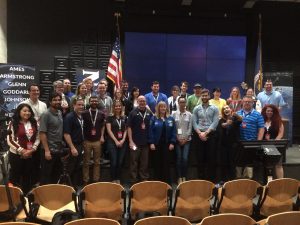
To cap off the day’s tours, we headed back to the Wallops visitor center, where this journey all began, to hear from the Science Ambassador Keelan Hamilton, talk HaloSat science with Anna Zaiczyk and hear wonderful stories and insight to being an astronaut from Kay Hire! A wonderful way to finish off the very long day.
And with the end of Sunday, came the anticipation for Monday.
Launch:
Rule #1: “Don’t try to film the launch or take photos. Put the phone down and experience the launch.” I heard this a few different times leading up to and at the event. I mean, I’ll watch the launch but I have to have the cameras. What I didn’t understand was, it’s not about not filming the launch, it’s about not thinking about anything else during the launch in order to focus all of your senses on the rocket, the engines, the flame, the smoke, the light in the sky, etc. Sure, you can film or photograph the launch and still “watch” the launch but is your mind and all of your senses being shared with your need to capture the event as well as experience the event? Until you’ve attended a launch in person this is not totally clear.
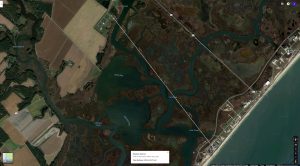
1:30 am: wake up. 2:00 am: leave for the Lockheed Martin parking lot to get on the bus. 2:30 am: buses depart. 3:00 am: arrive at the NASA viewing area approx 2-miles west of the O-A Launch Pad on Wallops Island. We debarked from the bus. The thick, wiry grass was wet. The air was wet. It was still night time. I was still half asleep. Off in the distance was this tiny rocket who’s launch pad’s lights illuminated the surrounding sky. Behind me was a large hospitality tent with proper lighting, coffee, and donuts with tables and chairs so that you could sit. Some people in the tent were vlogging, while other clicked away on their laptops, presumably NASA people doing work and still others simply chatted away the hour and a half before the main event. Further back behind the tent was a small, rectangular concrete building, perhaps a shelter of sorts where a very large loud-speaker was mounted. From the mouth of the loud-speaker, we could hear the voice of Orbital ATKs Mike Bitzer from what I like to call them “mission control” running through all of the flight checks, one by one. Surreal is the only word that comes to mind as I had heard the go, no-go run down so many times before but never for a real launch and never in person.
In the open grassy field where dozens of photographers and film crews had placed their tripods in a row, side by side, trained at the well-lit rocket, I found my place at the end of the line and began to set up my three cameras (I pretty much ignored the rule above). My Sony would do the heavy lifting and film the event in 120 fps using my Canon 70-200mm L lens on one of my two tripods. Mounted on my other tripod, the Hasselblad with the 40mm Distagon lens would be the time-lapse rig and capture the entire event from lift off and beyond with one 3-minute exposure. Lastly, mounted on a friction magic arm would be my Canon 5D mrk ii with the 50mm F/1.4 lens to record the overall event in 24 fps.
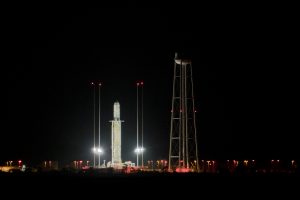
3:15 am: I hear mission control say that the Weather team is not happy with the weather and needs to push the launch to the end of the 5-minute window made available to the launch team. Why only a 5-minute window, you ask? Or better yet, why a 4:39 am launch? Good question. Because this launch carried important cargo for the international space station or ISS, the rocket needs to align itself with the ISS as it flew over us not too long before the actual launch. The 5-minute window is what was built into the rocket’s fuel to weight ratio. With the available fuel on board, NASA could afford to wait up to 5 minutes and still have enough fuel to boost a little longer and steer a little bit more to align itself with the ISS. To make that window bigger, they need more fuel. To accommodate more fuel, they would need to remove precious cargo. It’s a trade-off. The new potential launch time is 4:44. 3:16 am: my head drops in disappointment as I fear they will scrub the launch and there is no way for me to extend my stay one more day.
As dramatic as that may sound I pushed on with the setup of my gear. All cameras were set, everything switched off while we waited, chatting with the other photo enthusiast on either side of us, sharing other launch stories, showing off other launch photos, none of which I could share. It was my first launch. As I listened to the loud-speaker I picked out words like “anomaly”, “fire alarms” and other phrases that did not inspire confidence that this launch would happen. Those around me set timers on their phones to help them know where we were in the countdown while others fussed with their cameras by way of cell phone flashlights. I simply stood there staring at the rocket, 2-miles away and thought about what I needed to do once the launch was set in motion. This was, after all, a one-shot deal. My neighbor and I talked about our YouTube channels in an effort to pass the time. We also shared in the fact that it was his first launch as well. I can’t speak for my neighbor but although I was listening to what he had to say, I confess my ears were also listening to what the loud-speaker echoed from mission control in the hopes that I wouldn’t miss any good news.
~3:35 am: The weather team came over the loud-speaker and said that weather was clear and that they were a “GO”. Good news! And the crowd went wild! Well, there were some relieved cheers at least. I know I was happy but it wasn’t until I heard the following that I really got excited.
3:40 am: Time to get serious. Camera(s) rolling. The sound of cameras clicking away was akin to a sporting event without all of the action. We watched. We listened. We waited for the countdown to sound off in earnest. And then it happened, the numbers began to sound off, one by one. This was happening! Three…Two. One. 3:44 am: And for a brief moment, nothing happened. Then a small flash of light at the base of the rocket followed by a much bigger flash of light and ultimately the culmination of many, many months, possibly even years lit up the night sky as the rocket’s engines roared to life at full throttle. The white plume of smoke consumed the launch pad and glowed a soft orange as the rocket slowly lifted. It was only cheers and applause that I heard. It didn’t matter. The rocket was pointed to space and on its way. The rocket’s engine produced this amazing flame, white-orange as it exited the engine then it transformed into a cosmic blue as it fluttered and disappeared into the black of the night sky. Juxtaposed to the water tower that stood next to the rocket on the launch pad, the rocket seemed to move in slow motion as it cleared and left it’s neighbor behind. Approximately 12 seconds after the countdown had reached zero, the sound waves of the engine’s crack and thunder finally reached us. It was at that moment that I was in awe. The only word that I could find to describe it as it raced to the clouds was “beautiful”.
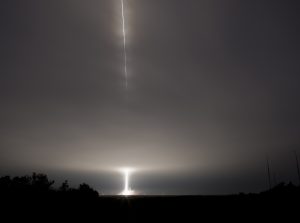 Straight up for 30 seconds is what we were told before the launch. Indeed. Straight up. It seemed so unnatural for the rocket to go straight up. Every photo I had ever seen showed the rocket travel in this glorious arch across the sky. In fact, this rocket was no different. After the initial 30, seconds the rocket turned north-east and began to track the ISS. Stage one was spent and stage two kicked in. We listened to the loud-speaker to track the progress but we also knew it was time to pack up our gear. The buses would be leaving before too long and although there was still so much for the rocket and Cygnus to do, the main attraction was over. Days would pass before Cygnus would meet up with the ISS and our time here was complete.
Straight up for 30 seconds is what we were told before the launch. Indeed. Straight up. It seemed so unnatural for the rocket to go straight up. Every photo I had ever seen showed the rocket travel in this glorious arch across the sky. In fact, this rocket was no different. After the initial 30, seconds the rocket turned north-east and began to track the ISS. Stage one was spent and stage two kicked in. We listened to the loud-speaker to track the progress but we also knew it was time to pack up our gear. The buses would be leaving before too long and although there was still so much for the rocket and Cygnus to do, the main attraction was over. Days would pass before Cygnus would meet up with the ISS and our time here was complete.
There was a high associated with the launch but that high faded as sleep depravity kicked in. I clung to the feeling and memory of the launch, the colors, the impact of the engine’s thrust in the air as I boarded the bus but the thought of a nap was very enticing. Only one item remained on the NASA Social schedule and it was listed as optional. The “Post Launch Briefing”.
I debated attending this briefing. I was exhausted. What changed my mind was the revelation that everyone was exhausted but the post-launch briefing needed to happen and I needed to attend. The briefing wasn’t an opportunity for NASA, Cygnus or ATK to toot its success trumpet. It was a clinical recap of the events that transpired. It was a time to share all that ailed the launch, beyond the weather concerns, much of which the public was unaware of. It was a time to reflect on the success but a time to consider the mission ahead. It was the perfect closure to an event that would forever change my perception of NASA, what they do and why they do it.

